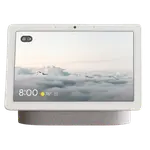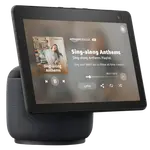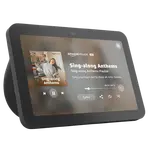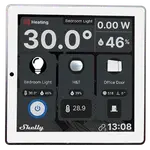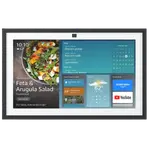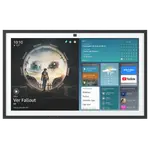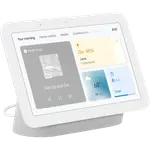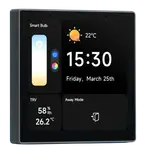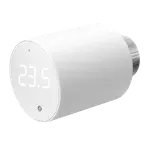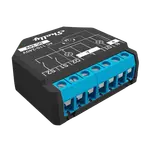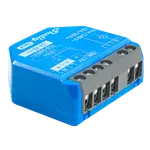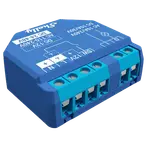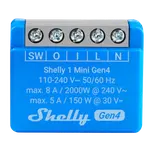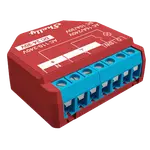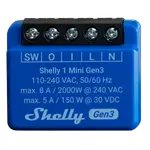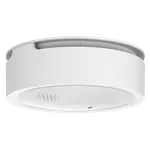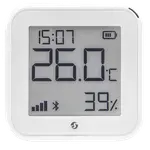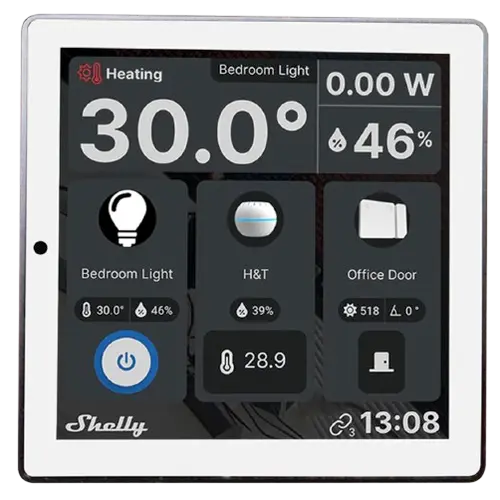
Shelly
Wall Display
Launch Year: 2024
Summary
Size & Materials: 180g / 6.35oz, 85 x 85 x 30 mm, Available in colors
Connectivity: 2.4 GHz Wifi, Bluetooth
Integrations: Home Assistant
Display: LCD, Color Screen, Touch Screen, 4”
Sensors: Temperature, Humidity, Ambient Light
Features: Wall Mount
Price History
Loading price history...
| Brand | Shelly |
|---|---|
| Headquarters | |
| Website | https://www.shelly.com |
| @shelly_IoT |
Size & Materials
Length x Width x Height
- Length: the longest side of the device
- Width: the shorter side of the device
- Height: the vertical dimension of the device
85 x 85 x 30 mm
The physical weight of the device, typically measured in grams (g) or ounces (oz).
Weight can be important for installation considerations, especially for wall-mounted or battery-powered devices.
180g / 6.35oz
Different color options available for the device to match your home decor.
Color choices allow you to better integrate smart devices into your existing interior design.
YES
Connectivity
Range: The 2.4 GHz band offers a longer range, meaning it can cover larger areas and penetrate solid objects like walls more effectively than 5 GHz.
Speed: Generally, 2.4 GHz provides slower speeds compared to 5 GHz due to a lower maximum data rate.
Interference: More prone to interference since many other devices (like cordless phones, microwaves, and Bluetooth devices) operate on the 2.4 GHz frequency, leading to potential congestion and slower network performance.
YES
Range: Offers a shorter range compared to 2.4 GHz and may have difficulty penetrating walls and other obstacles.
Speed: Typically provides faster speeds and higher data rates due to more available bandwidth.
Interference: Less prone to interference as fewer devices operate on this frequency, leading to a more stable connection.
NO
Bluetooth is a wireless communication technology used for exchanging data over short distances.
Bluetooth enables devices to communicate wirelessly within a short range, typically up to 10 meters (about 33 feet) for most consumer devices.
YES
Ethernet is a widely used technology for wired networking, providing a stable and high-speed connection between devices on a local area network (LAN).
Speed: Ethernet can offer higher and more consistent speeds compared to Wi-Fi. Modern Ethernet standards can support speeds from 100 Mbps (Fast Ethernet) to 10 Gbps (10 Gigabit Ethernet) and beyond.
Stability and Reliability: Because it uses a wired connection, Ethernet is less susceptible to interference from other devices and physical barriers, leading to a more stable and reliable connection.
Lower Latency: Ethernet typically offers lower latency compared to Wi-Fi, making it ideal for applications that require real-time data transfer, such as online gaming and video conferencing.
Security: A wired connection is generally more secure than a wireless one, as physical access to the network is required to intercept data.
NO
Integrations
Google Home serves as a central hub for a variety of smart devices, including lights, thermostats, cameras, and speakers. It leverages Google Assistant for voice control, enabling users to manage their smart home with simple commands.
NO
Amazon Alexa is one of the most widely used smart home systems, known for its compatibility with a vast array of devices. Users can control everything from smart lights to appliances using voice commands through Echo devices.
NO
Apple HomeKit is designed for users in the Apple ecosystem, providing a seamless way to control compatible smart devices through iOS devices using the Home app or Siri. It emphasizes security and user privacy.
NO
SmartThings is a flexible platform that connects a wide range of devices from different brands, offering a unified interface for control. It supports various communication protocols, allowing for extensive device compatibility.
NO
Home Assistant is an open-source platform that allows for extensive customization and integration of a wide variety of smart devices. It supports a multitude of protocols and brands, making it ideal for tech-savvy users.
YES
Hub
Zigbee is a wireless communication protocol designed for low-power, short-range applications, commonly used in smart home devices, industrial automation, and other areas requiring reliable, low-data rate communication. It features low power consumption, making it ideal for battery-operated devices, and supports short-range communication, typically up to 100 meters. Zigbee employs mesh networking, allowing devices to hub data through each other to extend range and improve reliability. It supports data rates up to 250 kbps, suitable for small data packets, and ensures interoperability among devices from different manufacturers if they conform to Zigbee standards. Security is robust, with AES-128 encryption for data protection.
Zigbee devices need a Zigbee-compatible hub to connect and communicate with other devices in your smart home setup.
NO
Thread is a wireless communication protocol designed specifically for Internet of Things (IoT) devices, providing secure, reliable, and scalable networking. Unlike some other protocols, Thread is IP-based, which means it can seamlessly integrate with existing internet infrastructure. It operates in the 2.4 GHz frequency band and uses mesh networking to enhance reliability and extend range by allowing devices to hub data through each other.
Thread is optimized for low power consumption, making it suitable for battery-operated devices. It supports low-latency communication, which is crucial for real-time applications like home automation and security systems. The protocol ensures high security with AES-128 encryption and end-to-end security at the network layer. Thread also supports over-the-air updates, ensuring devices can stay up to date with the latest features and security patches.
Thread-enabled devices require a Thread Border Router (such as certain smart home hubs or routers) to connect to your home network and other Thread devices.
NO
Matter is a unified, open-source connectivity protocol designed to standardize and simplify communication between smart home devices from different manufacturers. Developed by the Connectivity Standards Alliance (formerly the Zigbee Alliance), Matter aims to improve interoperability, security, and reliability across various smart home ecosystems.
Matter operates over existing networking technologies, including Ethernet, Wi-Fi, and Thread, providing flexibility in device connectivity. Its IP-based nature allows seamless integration with existing internet infrastructure and cloud services. Matter uses a mesh networking topology, particularly when operating over Thread, to enhance range and reliability by allowing devices to hub data through each other.
Security is a cornerstone of Matter, with end-to-end encryption and secure device onboarding processes ensuring robust protection for data and privacy. Matter also supports over-the-air updates, allowing devices to stay current with the latest features and security enhancements.
NO
Display
The type of display technology used, such as LCD, OLED, E-ink, or LED.
Different screen types offer varying levels of visibility, power consumption, and image quality.
LCD
Indicates whether the display can show colors or is limited to monochrome.
Color screens can display more detailed information and provide a better user experience.
YES
Indicates whether the display responds to touch input for direct interaction.
Touch screens allow for easier navigation and control without needing physical buttons.
YES
The diagonal measurement of the display screen, typically in inches.
Larger screens are easier to read from a distance but may consume more power.
4”
The pixel dimensions of the display, indicating how sharp and detailed the screen output will be.
Higher resolution displays show clearer text and more detailed information.
?
Voice Assistant
Built-in Google Assistant for voice control and smart home management.
Google Assistant integration allows voice control of the device and access to Google's ecosystem of services and information.
NO
Built-in Amazon Alexa for voice control and smart home management.
Alexa integration provides voice control capabilities and access to Amazon's extensive library of skills and services.
NO
Video
Built-in camera for video calls, monitoring, or facial recognition features.
An integrated camera enables video communication and can provide visual confirmation for voice commands.
NO
The angular extent of the scene captured by the camera, typically measured in degrees.
A wider field of view covers more area but may reduce detail, while a narrower view provides more detail of a specific area.
-
Physical switch to disable the camera for privacy.
A hardware camera switch provides peace of mind by physically disconnecting the camera when privacy is desired.
-
Sensors
Detection of movement within the camera's field of view.
Motion detection is the most basic form of activity monitoring, triggering recordings and alerts when movement occurs.
NO
Measures ambient temperature in the surrounding environment.
Temperature monitoring helps maintain comfortable conditions and can trigger heating/cooling automations.
YES
Measures relative humidity levels in the air.
Humidity monitoring helps prevent mold growth and maintains optimal indoor air quality.
YES
Measures the amount of light in the surrounding environment.
Ambient light sensors can automatically adjust display brightness or trigger lighting automations based on natural light levels.
YES
Alerts
The device can detect unusual sounds, like glass breaking
NO
The device can detect unusual sounds, like your smoke alarm going off
NO
Features
Physical buttons or controls for adjusting audio volume.
Hardware volume controls provide quick access to audio adjustments without needing voice commands or app interaction.
NO
Physical buttons for controlling media playback.
Hardware playback controls offer convenient access to music and media functions without voice commands.
NO
Physical switch to disable the microphone for privacy.
A hardware microphone switch ensures complete privacy by physically disconnecting the microphone when desired.
-
Mounting hardware and design suitable for wall installation.
Wall mounting capability allows flexible placement and can save counter space while providing optimal positioning.
YES



